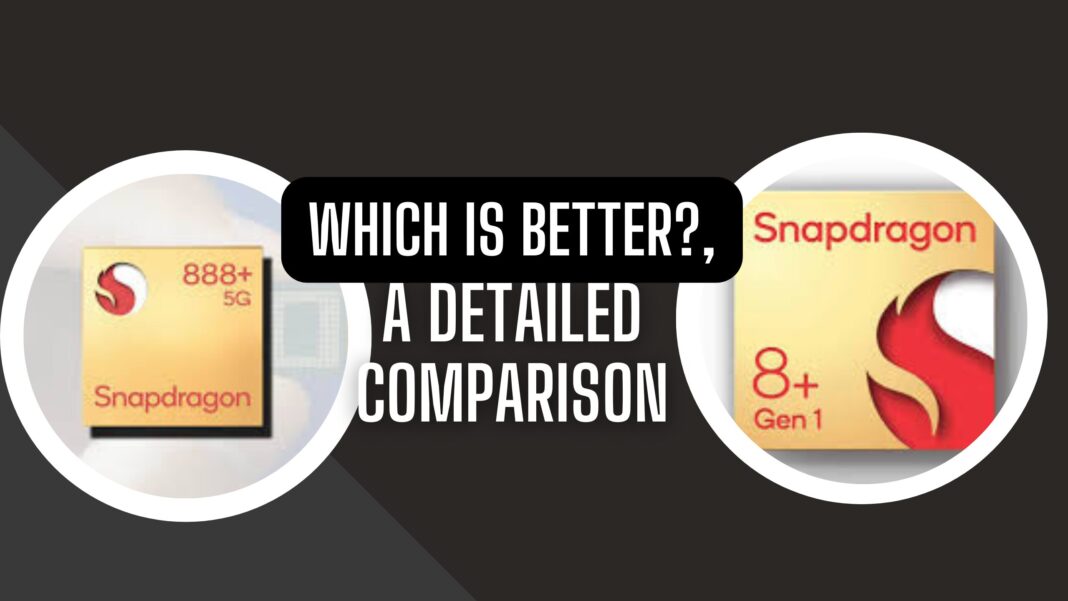When choosing a smartphone, the processor is one of the most critical components to consider. Qualcomm’s Snapdragon processors power many of today’s top Android devices, and two of the most talked-about chips are the Snapdragon 888 and the Snapdragon 8 Gen 1. But which one is better? In this comprehensive guide, we’ll break down the differences between the Snapdragon 888 and Snapdragon 8 Gen 1 to help you decide which processor suits your needs. Whether you’re a casual user, a mobile gamer, or someone who wants the best performance, this comparison will provide clarity.
Understanding Snapdragon 888 and Snapdragon 8 Gen 1
The Snapdragon 888, launched in December 2020, was Qualcomm’s flagship processor for 2021, powering devices like the Samsung Galaxy S21, OnePlus 9 Pro, and Xiaomi Mi 11. The Snapdragon 8 Gen 1, announced in November 2021, succeeded it as Qualcomm’s premium chip for 2022, featured in phones like the Samsung Galaxy S22, Xiaomi 12 Pro, and OPPO Find X5 Pro. Both are high-end processors, but advancements in technology mean they differ in performance, efficiency, and features. Let’s dive into the specifics to see how they stack up.
Manufacturing Process: 5nm vs. 4nm
One of the key differences between the Snapdragon 888 and Snapdragon 8 Gen 1 is the manufacturing process. The Snapdragon 888 is built on a 5nm process, while the Snapdragon 8 Gen 1 uses a more advanced 4nm process. A smaller process node means more transistors can fit on the chip, leading to better performance and improved power efficiency. This makes the Snapdragon 8 Gen 1 theoretically faster and less power-hungry, which can translate to longer battery life in real-world use. For users, this means smoother multitasking and less need to reach for the charger.
CPU Performance: Powering Your Apps
Both processors feature an octa-core CPU with a 1+3+4 core configuration, but the Snapdragon 8 Gen 1 has newer, more powerful cores. The Snapdragon 888 uses one Cortex-X1 core at 2.84GHz, three Cortex-A78 cores at 2.4GHz, and four Cortex-A55 cores at 1.8GHz. In contrast, the Snapdragon 8 Gen 1 boasts a Cortex-X2 core at 3.0GHz, three Cortex-A710 cores at 2.5GHz, and four Cortex-A510 cores at 1.8GHz.
The newer Armv9 architecture in the Snapdragon 8 Gen 1 offers a 20% boost in CPU performance and up to 30% better power efficiency compared to the Snapdragon 888’s Armv8 architecture. This means apps launch faster, and tasks like video editing or browsing feel snappier on devices with the Snapdragon 8 Gen 1. For everyday users, this upgrade is noticeable in smoother scrolling and quicker app switching.
GPU Performance: Gaming and Graphics
For mobile gamers, the GPU (graphics processing unit) is crucial. The Snapdragon 888 features the Adreno 660 GPU, while the Snapdragon 8 Gen 1 comes with the Adreno 730 GPU. The Snapdragon 8 Gen 1 delivers a 30% boost in graphics rendering and 25% better power efficiency compared to the Snapdragon 888. This results in higher frame rates and smoother gameplay in demanding titles like PUBG Mobile or Genshin Impact.
Additionally, the Snapdragon 8 Gen 1 supports advanced gaming features like Variable Rate Shading Pro and Unreal Engine 5, which enhance visual quality and performance in next-gen games. If gaming is your priority, the Snapdragon 8 Gen 1 is the clear winner, offering a more immersive and responsive experience.
AI Capabilities: Smarter Smartphones
Artificial intelligence (AI) is increasingly important in smartphones, powering features like voice assistants, photo enhancements, and notification management. The Snapdragon 8 Gen 1 has a 7th-generation AI Engine with a Hexagon processor that’s four times faster than the Snapdragon 888’s AI Engine. This allows for smarter features, such as real-time language translation, improved voice recognition, and better photo processing.
For example, the Snapdragon 8 Gen 1 can analyze and group notifications intelligently, making your phone feel more intuitive. If you rely on AI-driven features like Google Assistant or camera enhancements, the Snapdragon 8 Gen 1 offers a significant upgrade.
Camera Performance: Capturing the Moment
Photography enthusiasts will appreciate the improvements in the Snapdragon 8 Gen 1’s 18-bit Spectra ISP compared to the Snapdragon 888’s 14-bit Spectra 580 ISP. The Snapdragon 8 Gen 1 can capture 3.2 gigapixels per second, compared to 2.7 gigapixels for the Snapdragon 888. This results in faster image processing and better low-light photography, with 5x better low-light performance thanks to its Mega Low Light Mode.
The Snapdragon 8 Gen 1 also supports 8K HDR video recording in HDR10+ format, while the Snapdragon 888 is limited to standard 8K at 30fps. Both chips support up to 200MP photos, but the Snapdragon 8 Gen 1’s Bokeh Engine adds cinematic depth to videos. If you love taking photos or videos, the Snapdragon 8 Gen 1 delivers sharper, more vibrant results.
Connectivity: Staying Connected
Both processors support 5G, but the Snapdragon 8 Gen 1 has a more advanced Snapdragon X65 modem compared to the Snapdragon 888’s X60 modem. The Snapdragon 8 Gen 1 offers peak download speeds of 10 Gbps, compared to 7.5 Gbps for the Snapdragon 888. It also includes Qualcomm 5G PowerSave 2.0, which improves battery life on 5G networks.
Both chips support Wi-Fi 6E and Bluetooth 5.2, but the Snapdragon 8 Gen 1’s modem supports more global networks and frequencies, making it ideal for frequent travelers. For most users, the difference in connectivity may be subtle, but the Snapdragon 8 Gen 1 is better for future-proofing.
Battery Efficiency: Lasting Longer
Battery life is a top concern for smartphone users. The Snapdragon 8 Gen 1’s 4nm process and newer CPU cores make it up to 30% more power-efficient than the Snapdragon 888. However, some users have reported that the Snapdragon 8 Gen 1 can run hotter under heavy loads, like gaming, due to its higher performance. The Snapdragon 888, with a TDP (thermal design power) of 8 watts, is less efficient than the Snapdragon 8 Gen 1’s 5.3 watts, but some devices, like the OPPO Find X5, optimize the 888 for excellent battery life.
In real-world use, the Snapdragon 8 Gen 1 generally offers better battery management, especially for multitasking and light tasks. However, device-specific optimizations (like cooling systems) play a big role in actual battery performance.
Benchmark Scores: Measuring Raw Power
Benchmarks give us a clear picture of performance differences. In AnTuTu, the Snapdragon 8 Gen 1 scores around 1,000,000, while the Snapdragon 888 averages 800,000. In Geekbench 6, the Snapdragon 8 Gen 1 achieves a single-core score of ~1,200 and a multi-core score of ~3,400, compared to the Snapdragon 888’s ~1,000 and ~3,000, respectively. The Snapdragon 8 Gen 1’s 63% higher CPU score and 172% better GPU score in some benchmarks highlight its dominance.
These numbers confirm that the Snapdragon 8 Gen 1 outperforms the Snapdragon 888 in raw power, making it better for demanding tasks like video editing or gaming.
Gaming Performance: Real-World Experience
For gamers, the Snapdragon 8 Gen 1’s Adreno 730 GPU and Frame Motion Engine ensure smoother gameplay with fewer frame drops. In tests, devices with the Snapdragon 8 Gen 1 maintain higher FPS in games like Call of Duty Mobile compared to Snapdragon 888 devices. However, some users note that the Snapdragon 888, when well-optimized (e.g., in the OPPO Find X5), can still deliver excellent gaming performance with less heat.
If you’re a casual gamer, both processors are capable, but the Snapdragon 8 Gen 1 offers a more future-proof gaming experience with support for ray tracing and higher frame rates.
Heat Management: Keeping It Cool
One criticism of the Snapdragon 888 is its tendency to run hot during intensive tasks, earning it the nickname “induction heater” among some users. The Snapdragon 8 Gen 1, despite its 4nm process, can also heat up under sustained loads, like prolonged gaming sessions. However, its improved efficiency and newer architecture generally result in better thermal performance. Device manufacturers’ cooling solutions, like vapor chambers, significantly impact heat management, so the experience varies by phone model.
Which Should You Choose?
The Snapdragon 8 Gen 1 is the better choice for most users due to its superior performance, efficiency, and advanced features. It’s ideal for those who want a future-proof device for gaming, photography, or multitasking. However, the Snapdragon 888 remains a strong contender, especially in older flagships available at lower prices. If you’re not chasing the latest tech and your phone is well-optimized, the Snapdragon 888 can still deliver a smooth experience.
For budget-conscious buyers, Snapdragon 888 devices may offer better value, while tech enthusiasts will appreciate the Snapdragon 8 Gen 1’s cutting-edge capabilities. Check out the latest Snapdragon processor phones to find the best device for your needs.
Conclusion: The Future of Mobile Performance
The Snapdragon 8 Gen 1 outshines the Snapdragon 888 in nearly every category, from CPU and GPU performance to AI, camera capabilities, and power efficiency. Its 4nm process and newer architecture make it a powerhouse for modern smartphones, offering a smoother, faster, and more efficient experience. However, the Snapdragon 888 is no slouch and remains a solid choice for budget-friendly flagships.
Ready to upgrade your smartphone? Explore devices powered by these processors and find the perfect fit for your lifestyle. Share your thoughts in the comments below, and subscribe for more tech insights!
Need a laptop repair? Visit our Laptop Repair Services page for expert help.
Read more about our other innovative tech solutions.


